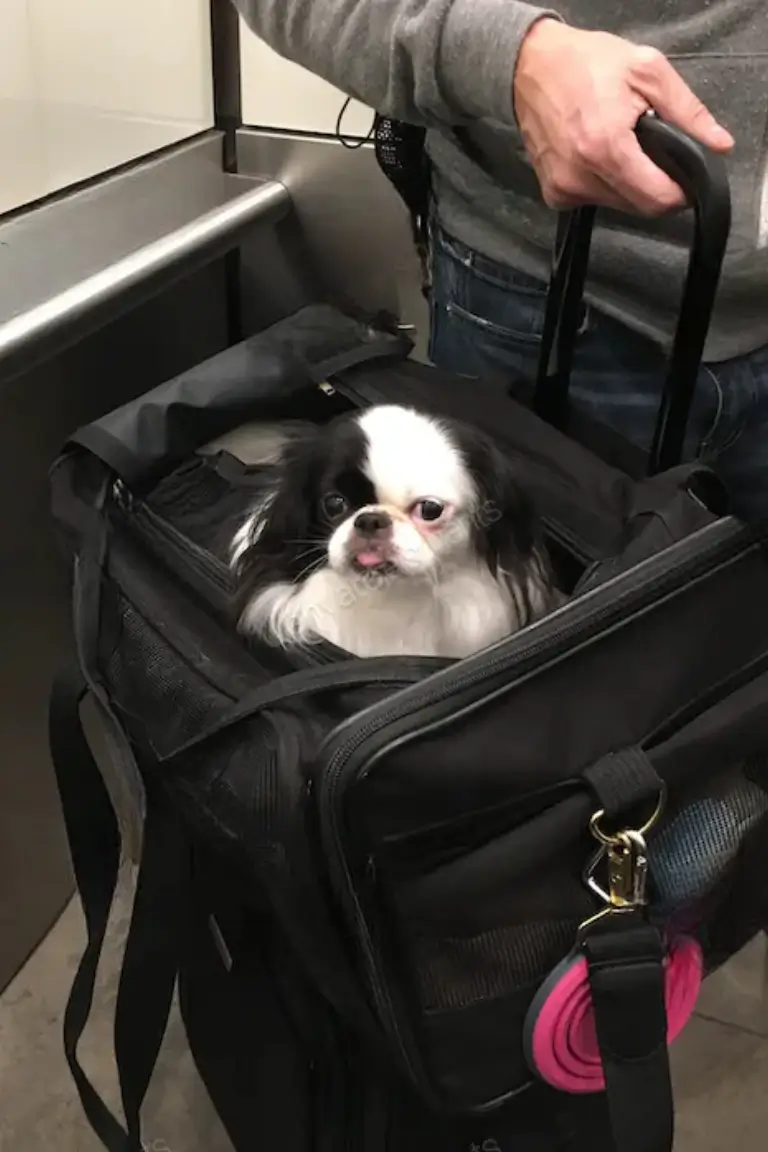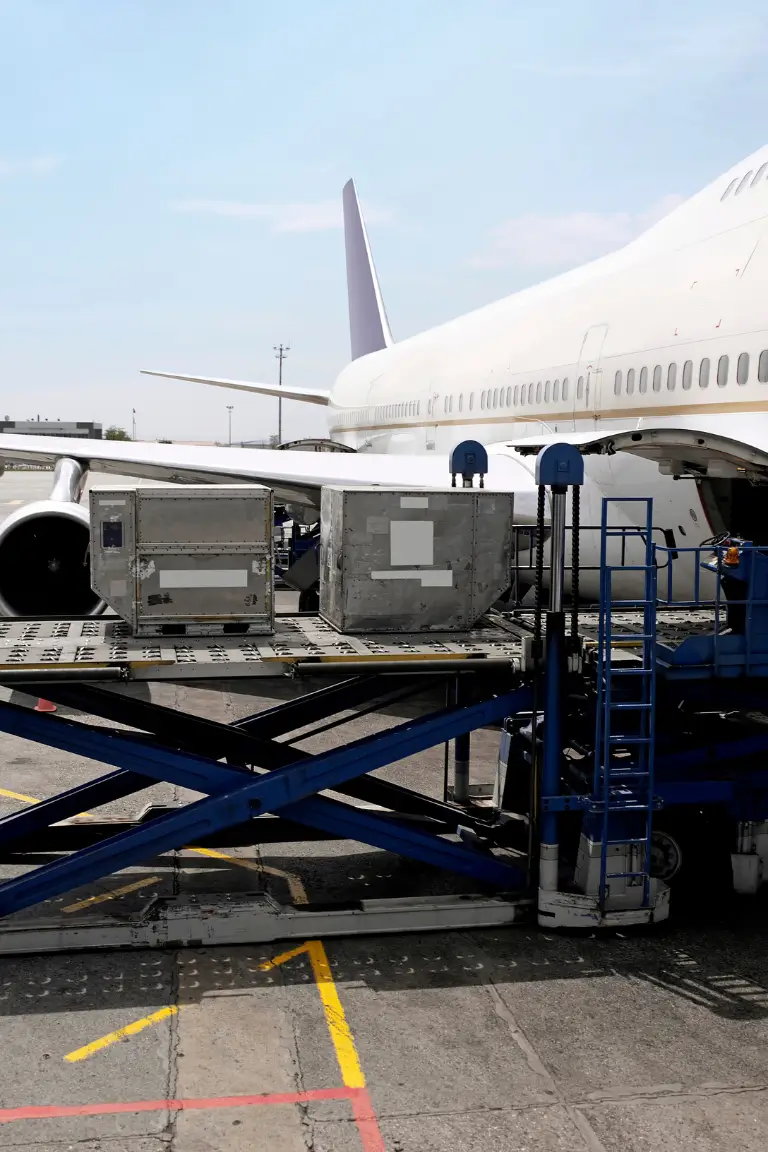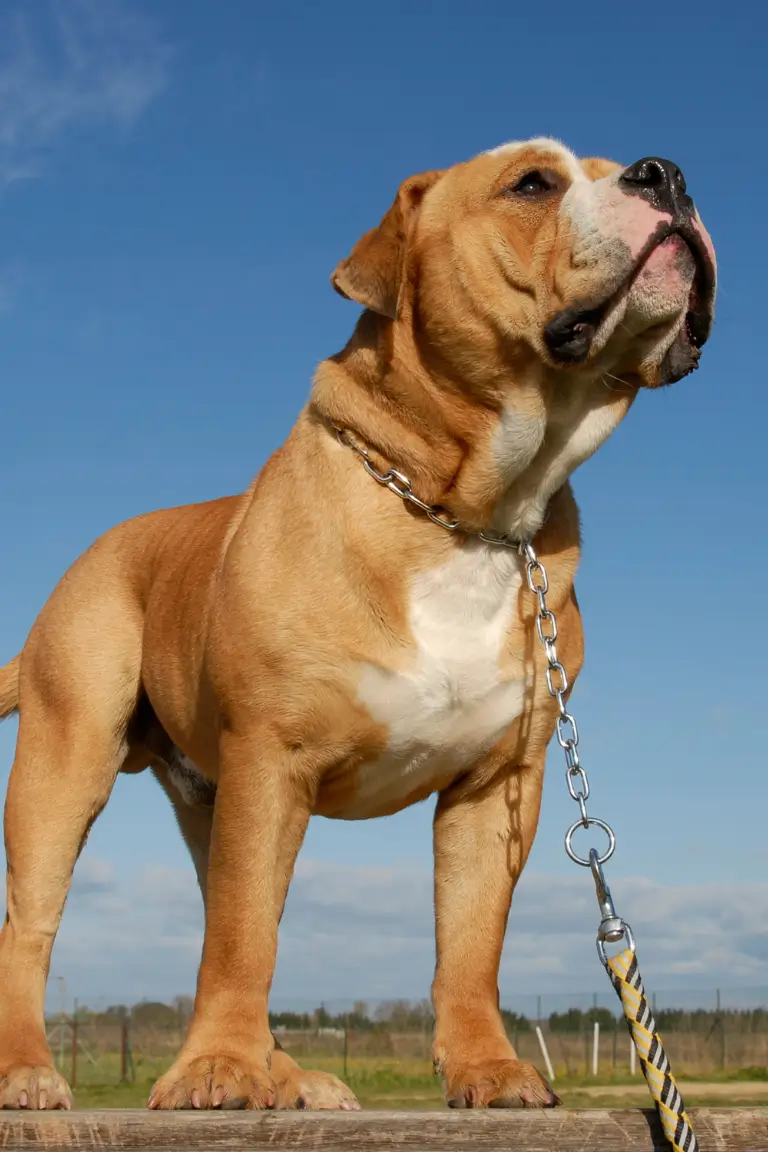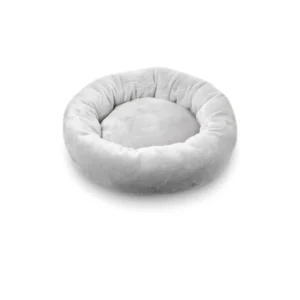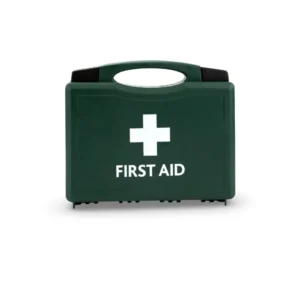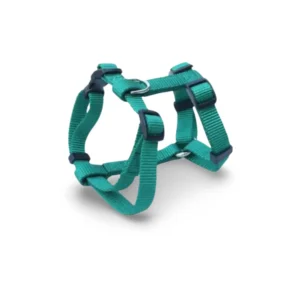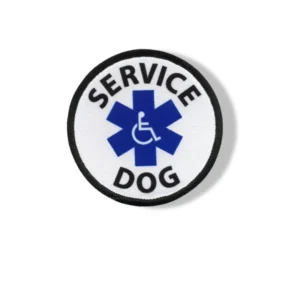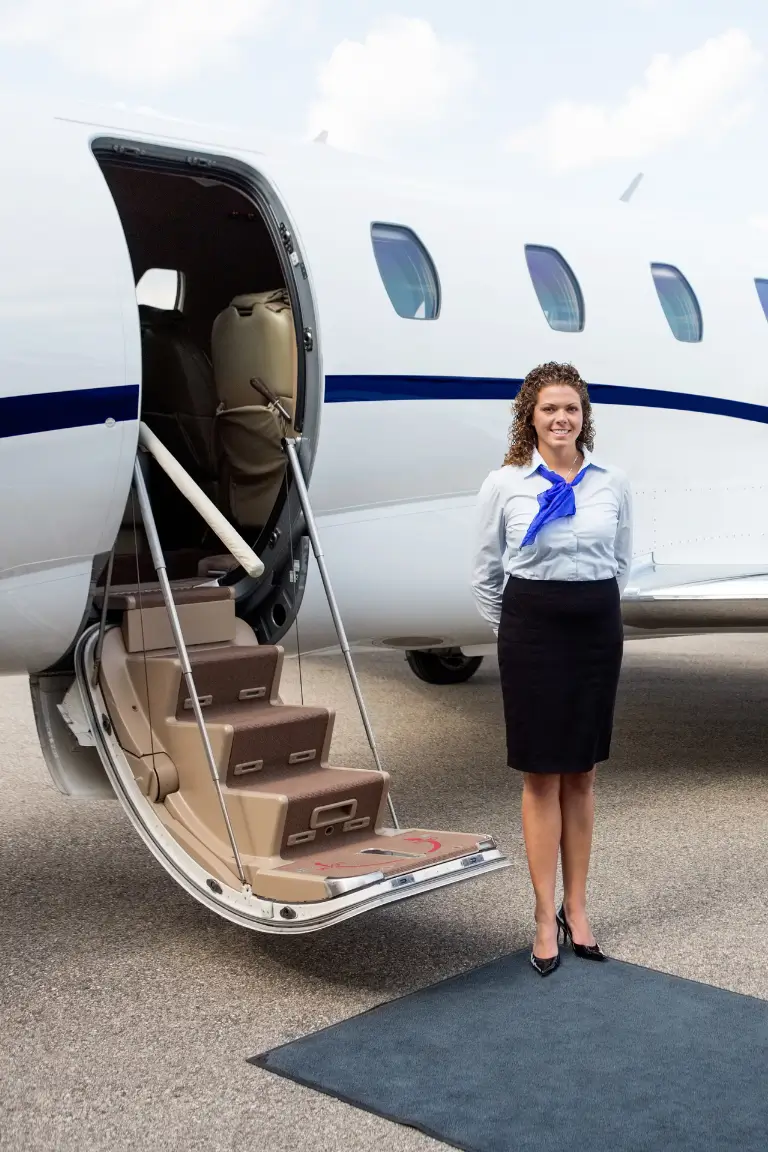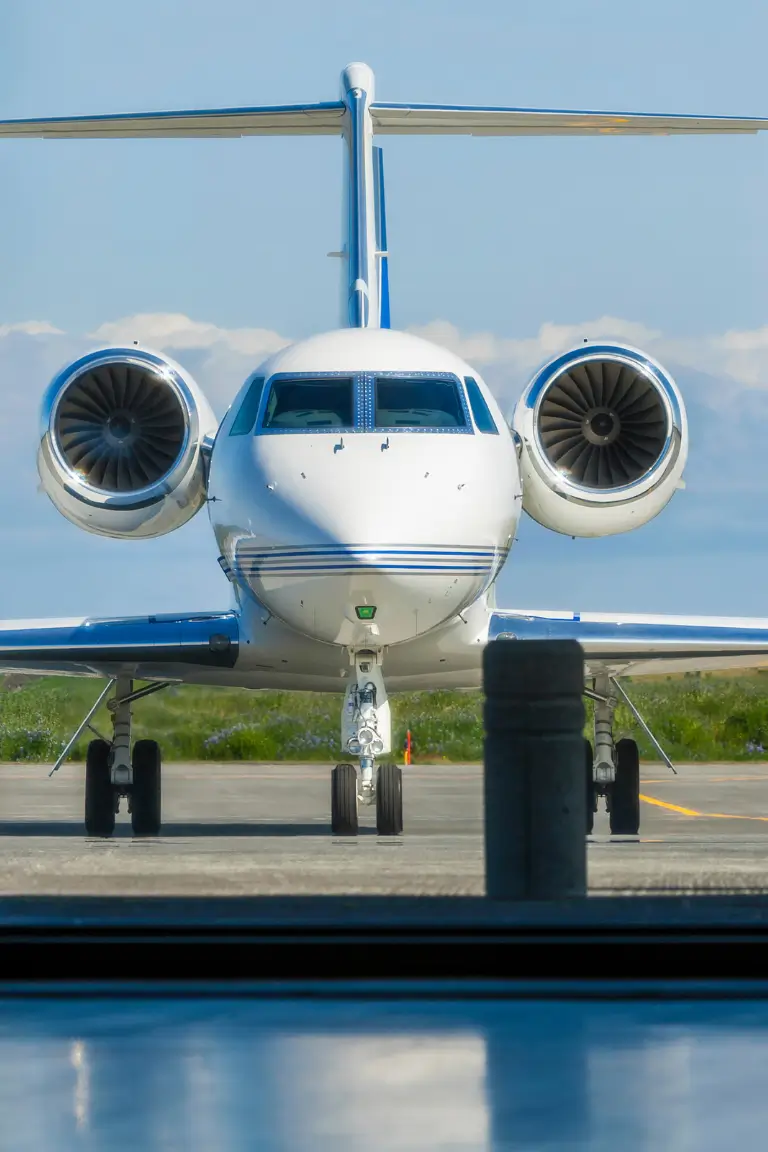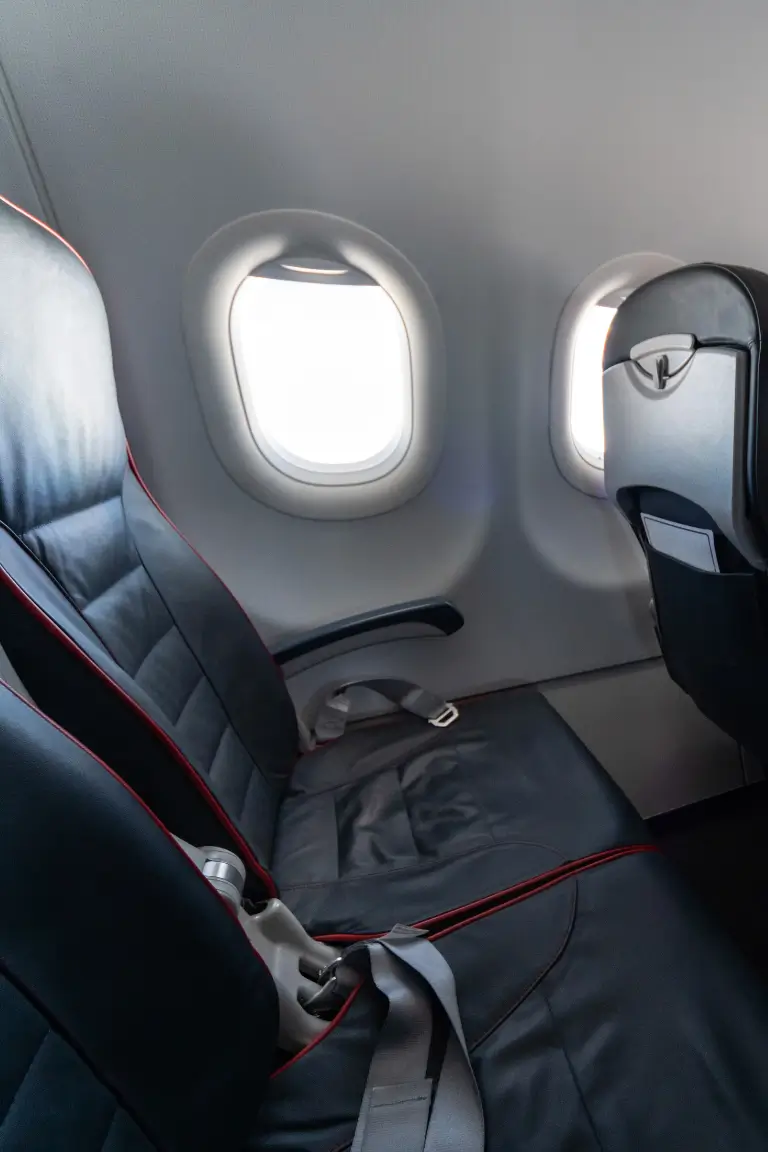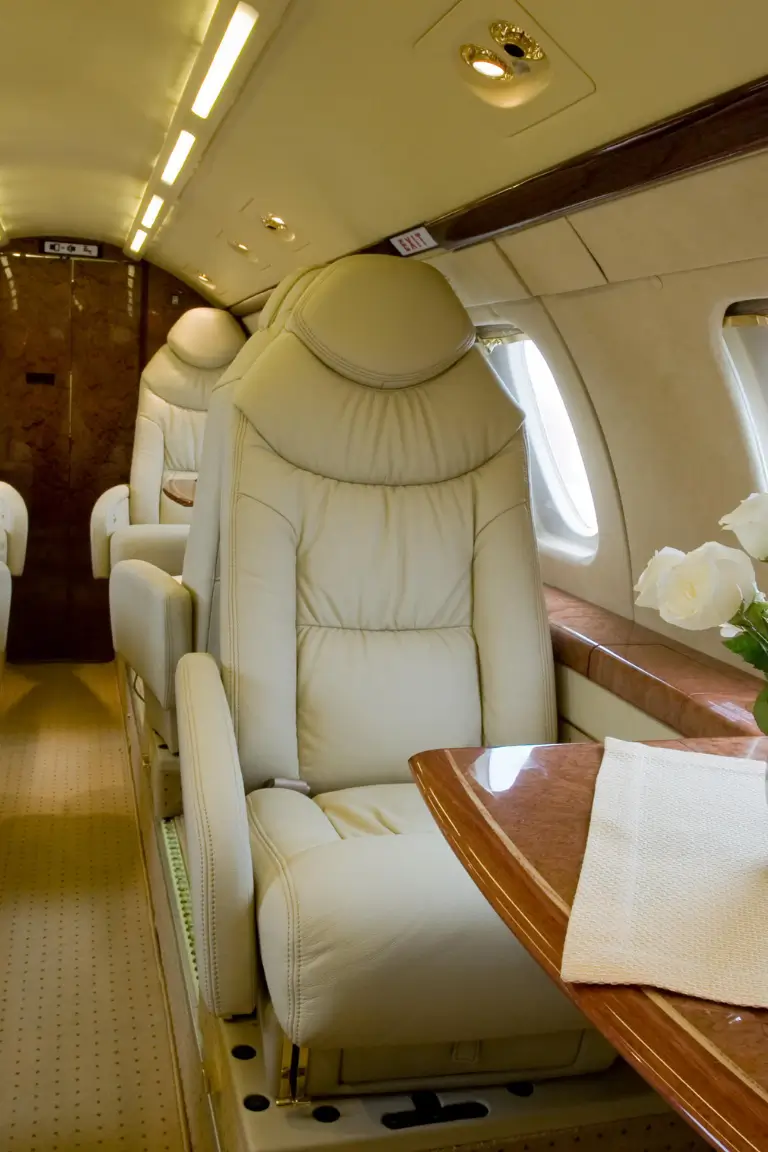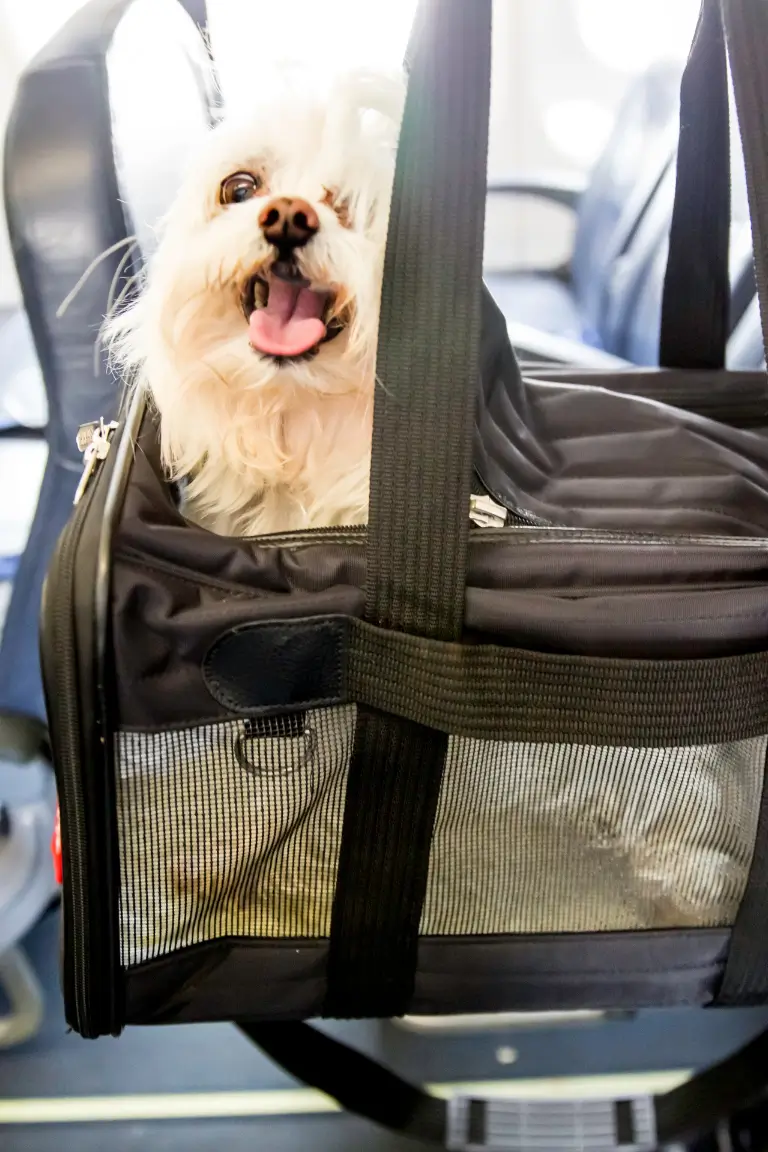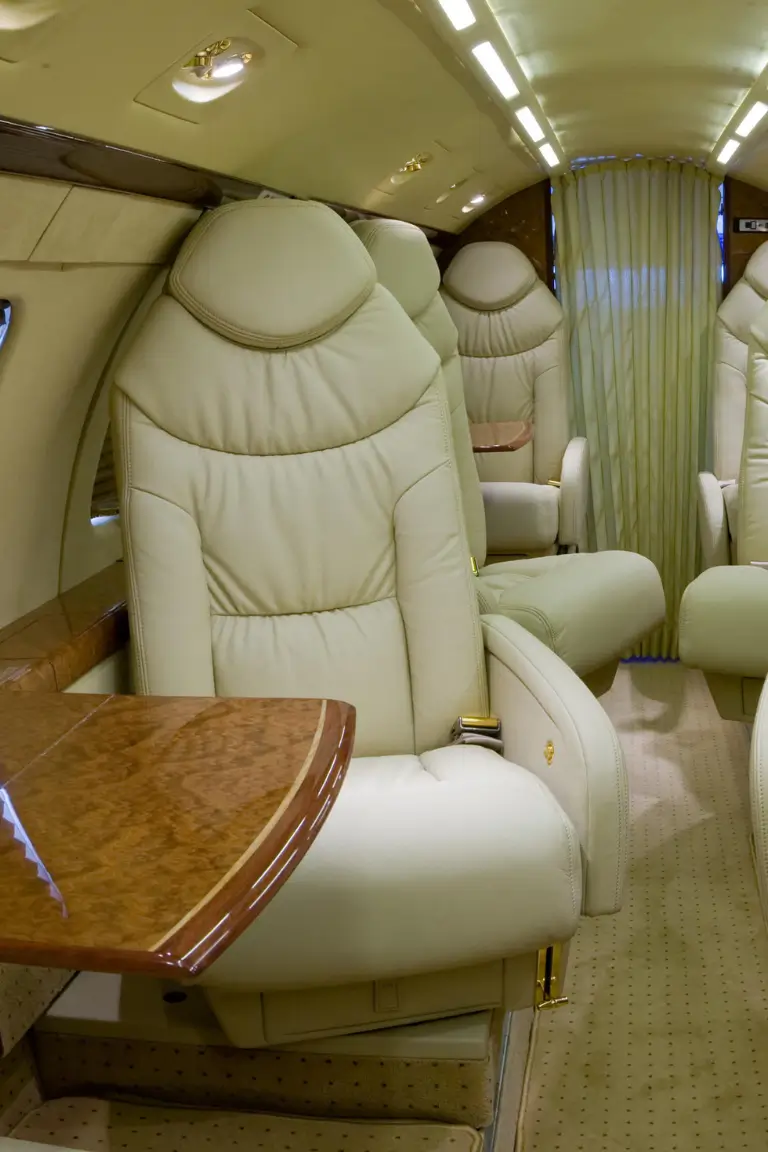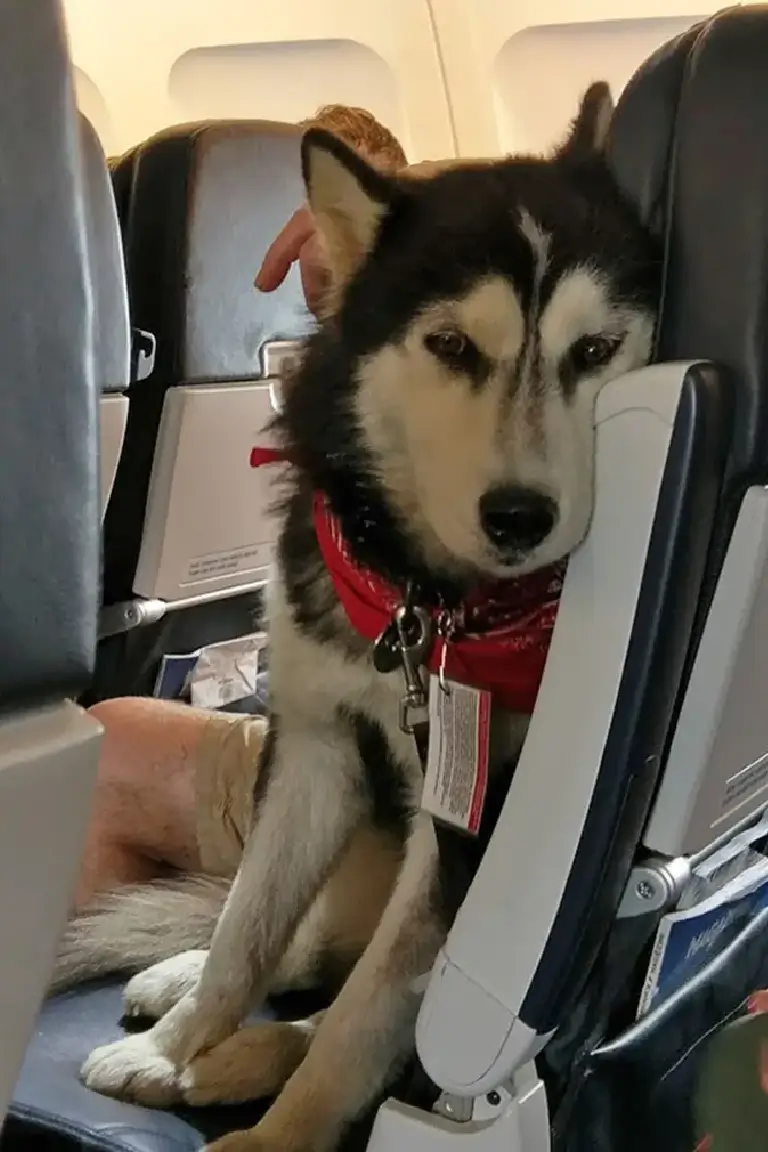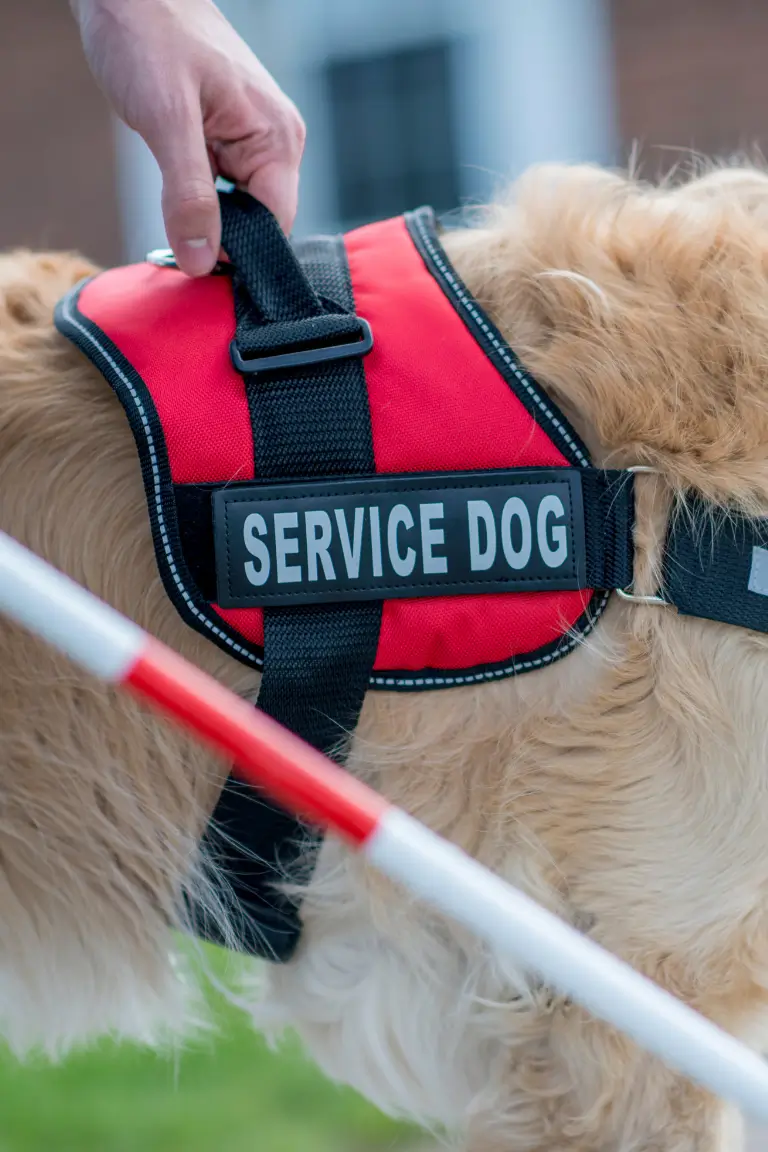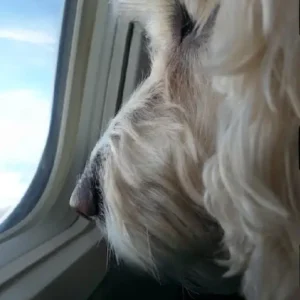As a dog mom, I love taking my Siberian husky on road trips.
However, it never crossed my mind that there may come a time when I’d have to buy a plane seat for him, until recently.
I decided to visit Japan for a two-week vacation and thought it would be great if my dog could sit next to me on the plane.
BUT can you really buy a seat for your pet?
I wanted to know the rules. So I did a lot of research.
Now I’m excited to share what I learned with you.
Key Takeaways
- It’s extremely rare for airlines to sell dog owners an extra seat for their pets.
- Major U.S. airlines do allow small dogs on board in an approved carrier under the seat.
- Expect fees of around $125 to $200 each way.
- Large dogs typically have to fly in cargo, as airlines don’t allow them a seat. There are exceptions for service animals.
- A small but growing number of private and semi-private airlines offer the option to purchase an extra seat for your dog. However, these niche services can be quite costly.
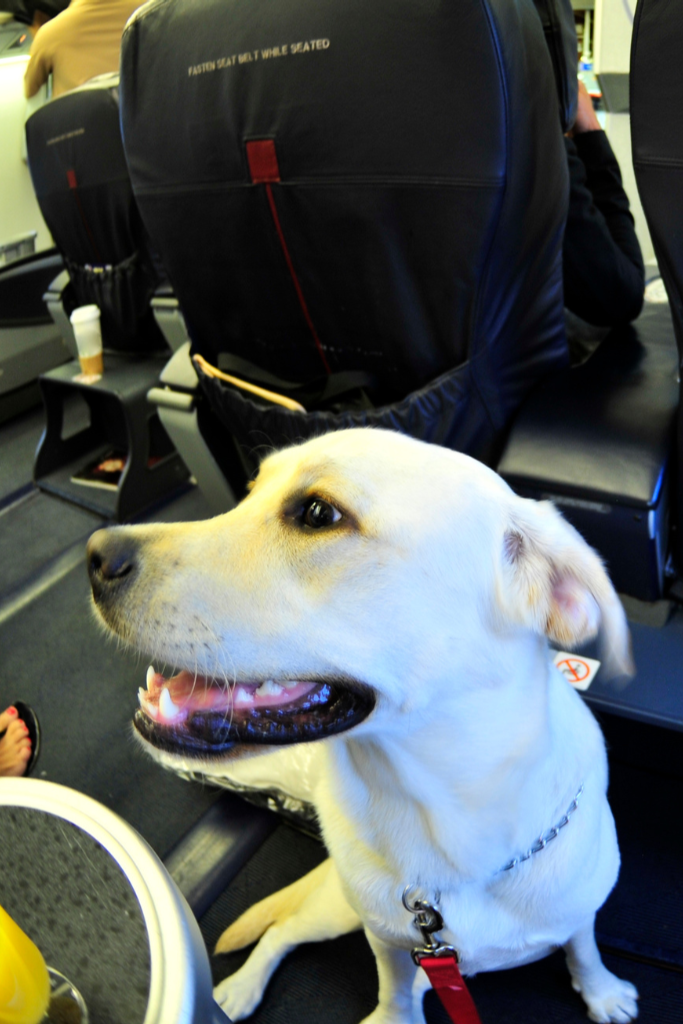
Furrtrekker is reader-supported. I may earn a small commission through these links. For more details, please read our privacy policy.
Can I Buy My Dog a Seat on an Airplane?
Unfortunately, most big airlines in the United States won’t allow dogs to have their own plane seat.
You can ask the airline if your pup can come along, but you’ll likely pay an extra fee.
Even then, it doesn’t guarantee them a seat.
That said, some private and semi-private charter jets actually let you BUY a PLANE SEAT just for your dog!
We’ll explore those soon, but first, let’s look at why buying a plane seat for your dog won’t work on most U.S. airlines.
Understanding Airlines Pet Policies
When booking a flight, you generally cannot purchase a plane ticket specifically for your pet to occupy their own seat.
Airlines have restrictions in place that prevent dogs from flying as passengers.
To understand why buying a plane seat for your dog isn’t feasible, it helps to review general airline pet travel policies.
Here’s how it works with the major U.S. airlines:
You can book a flight for your dog and pay a pet fee, usually around $125 each way.
This allows your dog to fly in-cabin with you if they are small enough to fit under the seat.
For large dogs that don’t meet the in-cabin size restrictions, they have to be booked as cargo.
The exception is trained service dogs, which can sit at their owner’s feet or on the floor.
Most airlines allow service animals to fly free of charge.
Emotional support animals used to fly free too, but policies have recently tightened.
Weight Limit
- Most airlines restrict in-cabin pets to dogs and cats under 15-20 lbs.
- For cargo, weight limits range from 50 to 150 lbs depending on the airline.
- Over that, you likely have to use a charter service.
Carrier Requirements
- In-cabin pets must fly in an approved carrier that fits under the seat.
- Dimensions are typically 18″ x 14″ x 9″ or smaller.
- Soft-sided is preferred in in cabin over hard carriers because they are more comfortable, less noisy, and safer in turbulence.
- Make sure there’s good airflow and it’s sturdy.
Age and Health Requirements
- Airlines generally require pets to be at least 8 weeks old and fully weaned to fly.
- You’ll need a health certificate from your vet for any dog flying as cargo.
- And some airlines ban snub-nosed dogs due to respiratory risks.
Pet Fees
- Expect to pay an extra airline pet fee of around $95-$200 each way for your dog to fly in-cabin.
- For cargo, fees are higher and range from $150-$1000+.
Travel Options for Flying with a Dog
When booking a flight with your furry companion, you essentially have two choices:
Cabin
For small dogs that meet airline size and weight restrictions, in-cabin travel is preferred.
Your dog can fly right under your seat in an approved carrier.
While they won’t enjoy a seat of their own, this option allows you to monitor and care for them during the flight.
Cargo
Your dog travels in the temperature-controlled cargo hold of the plane.
This is required for any dog too large to fit under a seat.
You won’t have physical access to them until after the flight when claiming them and their crate upon arrival.
Here’s an overview of the differences:
| Cabin | Cargo |
|---|---|
| Only for small dogs up to around 15-20lbs | Required for medium to large dogs up to 50+ pounds |
| Must fit in carrier under seat in front | Must use airline-approved crate |
| Small dogs remain with you in cabin | Medium to large dogs must travel in the temperature-controlled cargo area. (You won’t be able to see them during the flight.) |
| Safer than cargo in some cases | Higher risk of injuries if extreme turbulence |
Work closely with your veterinarian to determine if air travel is advisable for your dog based on health, breed, and temperament.
If flying seems too stressful for your dog, consider alternatives like pet transport services.
They handle all the details and paperwork to chauffeur your pooch door-to-door in a climate-controlled van.
Rules & Size Limitations for In-Cabin Pets
Rules and limits for in-cabin pets vary across airlines.
Be sure to verify specific policies with any carrier before booking.
Here are some of the major airlines’ general size and weight restrictions for dogs flying in the cabin:
Delta Airlines
- I browse Delta’s official website, and no explicit weight limit is stated for in-cabin pets.
- But the maximum carrier size requirement of 18″ x 11″ x 11″ implies pets must be small enough to fit comfortably in that space.
- Delta permits dogs and cats to fly in-cabin for approximately $75 – $200 pet fee each way (depending on the flight destination).
- Your fido must remain in an approved carrier and fit under the seat.
- Service and emotional support animals fly free.
For more info: Delta Airline Pet Policy
United Airlines
- United Airlines has no weight or breed restrictions for pets traveling in the cabin.
- In-cabin pets must remain in a carrier no more than 18″ x 11″ x 11″ (maximum dimensions for soft-side carriers) that fits beneath the plane seat.
- At United Airlines, the pet fee is $125 each way.
- If your dog is a service animal, they can be on board without a pet carrier.
- For domestic flights, your pet needs to be at least 8 weeks old, and for international, at least 12 weeks.
For more info: United Airlines Pet Policy
American Airlines
- Your dog and carrier combined may weigh no more than 20 pounds and must fit under the plane seat.
- Soft-sided carriers up to 18 x 11 x 11 inches are permitted for in-cabin pets.
- Hard-sided kennel max 19″ x 13″ x 9″.
- American Airlines allows one carry-on pet per passenger.
- There’s a $125 fee each way for carry-on pets traveling “within and between the United States and Canada, Mexico, Central America, and the Caribbean”.
For more info: American Airlines Pet Policy
Travel Tips
The process of air travel also involves walks through security screening where leashed pets must pass through metal detectors or baggage scanners.
Prepare your dog for these experiences with gradual exposure to avoid travel day surprises.
Southwest Airlines
- The airlines allow small, vaccinated dogs and cats under 15 to 20 pounds.
- The pet carrier must be leak-proof and breathable while fitting under the seat.
- Actually, Southwest has its own branded carrier.
- It has maximum dimensions of 17″ long x 10″ wide x 9.5″ high and can fit pets up to 15 pounds.
- However, if you want to use your own carrier, Southwest allows other soft-sided and hard-sided options with maximum dimensions of 18.5” long x 13.5” wide x 9.5” high.
- They charge a pet fare of $125 each way per pet carrier to fly a dog or cat in-cabin (this fee applies only to U.S. mainland flights).
- Pets are not allowed to fly in cargo holds on Southwest.
- Trained service animals and emotional support animals fly free on Southwest flights.
For more info: Southwest Airlines Pet Policy
Alaska Airlines
- For in-cabin pets, there is no explicit weight limit stated.
- However, pets must be able to fit comfortably inside an approved carrier that can be stowed under the seat.
- The maximum approved carrier dimensions are 17 inches x 11 inches x 9.5 inches (for soft-sided carriers).
- Pets traveling in baggage compartments in the cargo hold do have a weight restriction.
- The combined weight of the pet plus carrier cannot exceed 150 pounds.
- If your dog is over this limit, you would need to make arrangements with Alaska’s dedicated pet cargo service.
- Speaking of pets, Alaska Airlines lets you bring up pets like dogs, cats, birds, or rabbits in the main cabin for a $100 fee each way – but only if there’s room available.
- Notably, trained service animals can fly free of charge. Their access is protected under federal law.
For more info: Alaska Airline Pet Policy
JetBlue Airlines
- JetBlue allows small dogs and cats that weigh 20 pounds or less to fly in the cabin.
- Carriers must be leak-proof and able to be stowed properly while not exceeding 17″ x 12.5″ x 8.5″.
- There is a $125 fee each way to travel with a pet. Up to 6 pets are allowed per flight.
- JetBlue only allows trained service dogs to fly for free.
- Service dog owners must notify JetBlue at least 48 hours before the flight and complete the US DOT Service Animal Air Transportation Form.
For more info: JetBlue Airlines Pet Policy
Travel Tips
At the airport, look for special areas where your dog can go to the bathroom before your flight leaves.
This way your pup can relieve themselves in a designated spot instead of needing to hold it on the plane.
Hawaiian Airlines
- Hawaiian Airlines allows only small dogs and cats to travel in the cabin, with a combined weight of the pet and carrier cannot exceed 25 pounds.
- A watertight carrier with a maximum dimension of 16” long x 10” wide x 9.5” high fitting under the seat is mandatory.
- Along with a $125 one-way fee per animal (for flights between Hawaii and North America).
- Hawaiian caps one pet carrier per ticketed guest, with a maximum of 2 puppies or 1 dog or cat in the main cabin.
- Working dogs like guide dogs fly free after owners inform Hawaiian 48 hours early and submit paperwork.
For more info: Hawaiian Airlines Pet Policy
Spirit Airlines
- Spirit lets you bring small pets (dogs, cats, birds, and rabbits) under 40 pounds.
- inside if in a leak-proof soft-sided carrier not bigger than 18′′ x 14′′ x 9′′.
- Pay $125 each way per carrier.
- Service animals like trained dogs fly free if Spirit knows 48 hours ahead and gets DOT forms.
For more info: Spirit Airlines Pet Policy
Take note that pets count as your carry-on bag. They must stay in a carrier under your seat during the whole flight.
You must also follow country-specific pet import rules for bringing pets to other countries.
I know I just gave you a whole bunch of information, that might be overwhelming.
So to make it easier to read, here’s a table that lays out the major U.S. airlines’ rules and size limits for bringing in-cabin pets.
| Airlines | Dog Allowed | Pet Seat Allowed | Weight Limit | Carrier max dimension | Pet Fee (rough estimates) |
| Delta | Yes | No | No weight limit | 18″ x 11″ x 11″ | around $75 – $200 |
| United | Yes | No | No weight limit | 18″ x 11″ x 11″ | around $125 |
| American | Yes | No | Up to 20lbs | 19″ x 13″ x 9″ | around $125 |
| Southwest | Yes | No | Up to 20lbs | 18.5” x 13.5” x 9.5” | around $125 |
| Alaska | Yes | No | Up to 20lbs | 17” x 11” x 9.5” | around $100 |
| jetBlue | Yes | No | Up to 28lbs | 17″ x 12.5″ x 8.5″ | around $125 |
| Hawaiian | Yes | No | Up to 25lbs | 16” x 10” x 9.5” | around $125 |
| Spirit | Yes | No | Up to 40lbs | 18′′ x 14′′ x 9′′ | around $125 |
As you can see, the requirements are quite restrictive for major US airlines.
Though rules differ, pet fees range from $75-$200 across airlines.
These tight restrictions mean most medium, large, or giant size breeds can only fly as cargo in the hold.
Other Rules and Regulations You Should Know
Besides the basics we just covered, there are a few other rules you should know about flying with your dog:
Flying with Specific Dog Breeds
Regulations around flying with dogs vary based on breed.
Due to respiratory sensitivity at high altitudes, many airlines ban brachycephalic (snub-nosed) dogs like Boxers, Bulldogs, Pugs, and others from travel altogether.
Giant breeds exceeding 100-150 pounds fall outside most airline weight restrictions.
Make sure your pet meets all breed requirements before purchasing tickets.
Emotional Support Animals
There are special provisions for service animals and emotional support pets (ESA).
For emotional support dogs specifically, airlines can’t restrict the breed or size, which is good.
But proper documentation is still required, of course.
The policies around emotional support animals have gotten a bit tighter lately though. Most airlines now charge a fee for them and require additional documentation.
ESAs no longer qualify as service animals so other regulations like leash requirements still apply, unlike service dogs.
Service Dogs
Specialized service dogs that assist disabled passengers continue to fly for free on most airlines.
They don’t require a pet carrier but must be leashed at all times.
Accommodating service dogs is a requirement at all airports and for all airlines under the Air Carrier Access Act (ACAA).
There are no additional fees or size limits as well.
Documentation demonstrating their training is not really required.
BUT the airline may ask for a DOT Service Animal Air Transportation Form that says the dog is healthy, well-behaved, and trained.
Shop My Favorites
Exploring Solution: Private & Semi-Private Jets Offer the Most Flexibility
While the vast majority of major commercial airlines don’t allow dogs on board in a seat, these are the private charter and semi-private flight services that actually do offer such an option— for a hefty price tag!
JSX
JSX, also known as JetSuiteX, is a semi-private air carrier that flies within and between states in the U.S. and Mexico.
They offer direct flights between places like California, Arizona, Nevada, New Mexico, Texas, Florida, and New York, as well as Baja California, Mexico.
The best part is you don’t have to deal with TSA screening to board!
You can transport cats and small dogs for free within the cabin if they are securely fastened inside a carrier (13″ x 11″ x 17″).
No other pets besides cats and dogs are allowed.
There is a pet fee of around $100 (one-way flight) for customers transporting a pet in-cabin.
One thing I love about JSX is their policy for medium and large dogs.
If your pup is too big, they can fly right in the cabin with you, out of their carrier, for the price of a second seat.
You just have to call customer support to book the seat for your dog and their floor space.
However, they can’t sit on your lap or in the seat next to you, but booking them their own space is pretty sweet.
Customers who purchase a window seat and an aisle seat can bring larger dogs inside the cabin as long as they are leashed.
You do have to fill out their pet liability form and present it before boarding.
Make sure to have all their health and vaccine paperwork in order as well.
Aero
Aero is one of the semi-private jet companies that provide pet seats for large dogs.
No maximum weight limit too!
You just have to contact their concierge team ahead of time to reserve a full-price seat for your Fido.
While there’s no cap on the scales for large pets, they must stay put in their seats and can’t be wandering the aisles.
Just a heads-up though, if your dog is smaller like 20lbs or less, he/she must travel inside a carrier no bigger than 20”x12”x9”.
Depending on your flight destinations, small pets under 20 pounds cost $300 (one-way flight) per leg of your trip.
Large dogs typically add upwards of $500 (full-price seat) to your tab for each leg, since they take up a whole seat.
Surf Air
Surf Air is a membership-based airline that flies to destinations across California and Texas.
They allow pets under 20 pounds to fly with you for just a $50 fee (plus tax).
Your little buddy just needs to be able to fit comfortably on your lap or at your feet during the flight.
But it’s only limited to one pet per flight.
If you’ve got a bigger pup that needs their own seat, you can buy them their own one-time flight pass.
And of course, service animals are always welcome without any extra fees or charges.
They get priority seating as well.
To make sure your dog is all set to fly, just shoot Surf Air an email 48 hours before takeoff to get them booked on your reservation.
Tradewind
Providing private charter and scheduled flights within North America and the Caribbean, Tradewind Aviation permits pets of all sizes on their aircraft (CJ3s and Pilatus PC-12s).
Yep, all sizes, including large dogs, to fly unrestrained in the cabin.
The only catch is that if your pup is over 100 pounds, you’ll need to purchase an additional seat for them.
This usually costs around $200-300 extra each way depending on your route.
Take note that it is only limited to pet per flight
This allows larger dogs to fly in the “Pet Cabin” area without being crated in cargo
So– yes, Tradewind does make special accommodations for large dogs.
While buying them a seat is quite expensive, it’s a unique option that allows bigger pups to travel comfortably in the main cabin.
Here is the table showing the private and semi-private jets that allow you to buy a seat on an airplane.
| Airline | Dog Allowed | Maximum Weight Limit | Pet Seat | Pet Fee (rough estimates) |
| JSX | Yes | Up to 79 lbs | Yes | $100+ per flight |
| Aero | Yes | No maximum weight limit | Yes | $200 – $500+ per flight |
| Surf Air | Yes | No maximum weight limit | Yes | $400 – $500+ per flight |
| Tradewind | Yes | No maximum weight limit | Yes | $200 – $300+ per flight |
Without space and weight restrictions, private jets are ideal for flying with large dogs.
Some luxury pet concierge services can arrange private charters specifically for pet travel.
Of course, the downside is this option can cost tens of thousands for a single flight!
But for those who can afford it, private charters offer the most flexibility and comfort for dogs.
Buy an Extra Seat for Yourself and Use it for Your Dog
All right, let’s be real – most of us aren’t flying private jets anytime soon.
But if you want some extra legroom on your next commercial flight, here’s a little trick: book an extra seat for yourself, then use it for your dog.
Select major airlines like Alaska, American, and Delta allow buying an extra seat on flights you’re already booked on.
You can then use this extra seat for your dog as long as they stay on the floor and don’t cause a safety issue.
Alaska Airlines: Comfort Seat.
Owners can purchase a comfort class seat with extra legroom to accommodate their dog on the floor.
Their “Comfort Seat” is essentially an extra seat purchased for yourself, which you can then use to hold your dog or other carry-on pet.
Remember that your dog still cannot sit on the comfort seat, they still need to be stowed in the plane seat inside the airline complaint carrier.
To utilize the comfort seat for a pet, owners need to pay for the actual seat which is around $100 – $150 (priced the same as the fare you select).
Plus, an additional $100 one-way pet fee.
Again, the purpose of the comfort seat is not for the pet to actually sit on the seat, but rather to use the floor space in front of the extra seat to accommodate a larger carrier or provide more room.
Pets still need to remain in their airline-compliant carriers.
American Airlines: Extra Seat
American Airlines does give you the option to book an extra seat on some flights.
Note that if you do buy an extra seat on American Airlines, it would be for yourself as the owner to have more space, not directly for your dog.
It’ll cost you the regular fare, so around $100-$125.
Be sure to notify the airline in advance that you’ll be traveling with your Fido, and pay the applicable pet fee plus the cost of that extra seat.
Delta Airlines: Extra Seat
You can buy an extra seat in certain Delta cabins to provide space for your dog.
Keep in mind, your dog isn’t technically allowed to use the seat.
They must remain in their carrier on the floor in front of the extra seat.
But by buying yourself an extra seat, you can create space for your dog in the carrier.
I checked with Delta and you have to call their customer service to book the extra seat.
It doesn’t always cost the same as a regular ticket either.
The price depends on the type of fare and how full the flight is.
JetBlue Airlines: Extra Seat
JetBlue allows you to book extra seats for your dog.
But they do need to stay in their carrier during takeoff and landing, just like on other airlines.
Once the plane levels off, though, you’re welcome to hold the carrier on your lap or place it on the extra seat.
However, not during take-off or landing, for safety purposes.
As for the cost, it’s basically like booking two seats for yourself – whatever fare class you select for your seat is what they’ll charge for the extra one too.
Selected International Airlines That Allow You to Buy a Dedicated Pet Seat
While options are still extremely limited across the U.S., a few other overseas airlines do allow pets to fly in the main cabin with their own purchased seat.
Regulations vary greatly, so connect directly with the carrier to verify their specific policies, prices, and restrictions.
Etihad Airways (United Arab Emirates)
If you’re booking a business or first-class flight on Etihad Airways, you have the option to purchase a dedicated pet seat for your dog.
This time around, your pet must remain in their carrier on the adjacent seat for the duration of the flight– they won’t be allowed under your seat.
The carrier dimensions when you buy an extra seat are:
- Length: 50 cm
- Width: 43 cm
- Height: 50 cm
And that’ll run you the cost of the seat plus a pet fee of $1,500 each way.
Good to know: This option is only available on Etihad-operated flights to and from Abu Dhabi.
T’way (South Korea)
Speaking of South Korean airlines, T’way Air has some neat perks.
If you want extra space, you can pay to guarantee the seat next to you stays empty.
The only catch is that you can only do this on the day of departure if there happen to be empty seats available.
Oh, and check this out – after 3 international T’way flights, your 4th pet ticket is free! So if you’re a frequent flyer with a furry co-pilot under 9kg, take advantage.
Pet Seat Fees For Dogs
In addition to airfare, expect to pay a pet fee for your dog on any commercial flight.
Some airlines break this out as a separate cost just for the animal, while others roll it into the total ticket price.
Some more things to know about pet fees:
- Pet fees are generally $100-200 each way on domestic U.S. flights.
- International journeys incur higher pet ticket costs, from $200-500+ per animal.
- This covers your airline’s costs of processing documentation, dedicating resources to traveling animals, and mitigating risks.
- Some carriers also charge administration fees just to process pet reservations or make changes.
- Others have an annual enrollment fee for flying with pets.
- Be sure to read the fine print when booking with your dog.
- Pet fees are rarely refundable, even if you opt not to ultimately fly with your pet.
- Airlines typically only offer travel credits when pet plans must change.
- Trip cancellation and interruption insurance is advisable to recover costs.
To recap, here are the general fee ranges charged by major U.S. airlines as well as private and semi-private flight companies:
In-cabin:
$95-$200 (rough estimates) each way.
The fee for your dog to fly with you in the cabin depends on the airline.
Cargo:
$200-$500+ (rough estimates) each way.
For cargo, fees also vary but tend to be much higher than cabin pets, especially if you have a large dog.
Buying a seat:
$200-$1000+ (rough estimates) per flight leg.
The few private and semi-private airlines that allow dogs to purchase a plane seat have fees starting around $200 and going up to $1000+ per leg.
Important Considerations Before Flying with Your Dog
Preparing your pup physically and mentally for air travel reduces risks and provides peace of mind.
To ensure a smooth trip, here are some tips for preparing your dog for air travel:
Health certificates:
- Airlines mandate a valid health certificate or veterinary clearance form issued by a licensed vet within 10 days or less of travel.
- This confirms up-to-date vaccines and that your dog is fit to fly.
- Be aware of any pre-existing health conditions air travel could aggravate.
Travel restrictions:
- Research breed restrictions, which commonly apply to snub-nosed dogs with respiratory limitations.
- Keep travel durations reasonable with stops to let your dog relieve themselves and reduce anxiety.
- Follow all safety protocols.
Documentation Guidelines:
- Have your dog’s identification papers and all travel documents in order well beforehand.
- This includes health clearances, airline forms, international permits, proof of age, and more.
- Thoroughly understand each airline’s policies.
Veterinary consultation:
- Schedule an appointment with your vet 4-6 weeks before traveling to discuss your dog’s airworthiness.
- They can prescribe anti-anxiety or anti-nausea medication if needed and provide documentation.
Travel Documents and Permits:
- Research if any special permits, exams, or paperwork like an import license are mandatory when traveling to your destination.
- Acquire these well in advance since processing can take weeks.
- Have copies ready to present at check-in, security, and upon arrival.
Crate Training
- If your dog will ride in cargo, they must be fully crate trained beforehand.
- Leave the crate accessible at home with the door open so it becomes a safe space. Randomly place your dog in the crate for brief periods, providing rewards.
- Slowly increase the duration.
Car Rides
- Take your restrained dog on local car trips to get them acquainted with motion sensations.
- Start with very short distances and slowly work your way up to longer drives.
- Always reward calm behavior generously.
Exposure to Crowds
- Bring your leashed dog to outdoor venues like parks, markets, or sidewalk dining where they can experience new sounds and smells.
- Have them sit calmly and reward them for proper manners around crowds.
- Introduce travel gear like their harness.
Flying with your dog can be a rewarding experience with cherished memories made.
But the health and comfort of your furry co-pilot always comes first.
Safe travels to you both!
FAQs
Some common questions I get from fellow pet parents:
Can Dogs Fly in First Class?
Most airlines restrict pets to only economy or coach class cabins due to a lack of underseat storage space.
The few exceptions are for recognized service dogs that legally cannot be excluded based on class.
Otherwise, in-cabin pets must remain at the passenger’s feet with more foot room.
What’s the Best Plane Seat When Traveling With a Pet?
I highly recommend that you choose A window seat, since it has more space underneath.
This allows your pet a bit more room to get comfortable.
Can I take my dog out of the carrier on the plane?
FAA regulations require all pets remain in their carriers during taxiing, take-off, landing, and turbulence.
For their safety, dogs should stay in the carrier the full flight.
Is It Safe For Large Dogs to Fly As Cargo?
According to most veterinarians, flying a large dog in cargo carries more risks than cabin travel. However, with proper precautions, thousands of large dogs fly safely this way every year.
Use an airline-approved crate, don’t tranquilize your dog, follow the health guidelines, and avoid extreme temperatures.
Can I Give My Dog A Sedative For The Flight?
You should avoid sedating your dog with over-the-counter supplements or drugs.
Talk to your vet beforehand if you feel your dog needs prescribed anti-anxiety medication.
Get the airline’s approval as well, as excessively sedated dogs may not be allowed to fly.
More Travel Blogs:
Furrtrekker Travel Checklist
Packing List
Carrier & Other Travel Accessories
- Airline-approved carrier that fits under the seat (Properly labeled with your contact information and "live animal")
- ID Tags
- “Live Animal” sticker
- Bedding, pee pads, and/or absorbent material
- Collar and leash stored inside
Cleaning Supplies
- Poop bags wipes, & towels
- Small first aid kit
Documents
- Health certificate from vet
- Up-to-date rabies vaccination records
- Breed verification form if required by airline
- Customer acknowledgement form if required by airline
- Airline pet policy
- Payment receipt as proof of pet ticket
- Vaccine records
- Emergency vet contact info
For Your Dog
- Prescription medications if needed
- At least 2-3 meals’ worth of dog food
- Collapsible food & water bowls
- Water bottle
- Bandana or blanket with your scent to comfort your dog
- Toys & their favorite treat
For You
- Print out of airline pet policy
- Payment confirmation that shows your dog is booked
- Photo of your dog
- List of contact info for your vet and local emergency vet
How to Organize and Pack
- Stay organized = less stress for you + pets! Split items between bags smartly. Packing right helps big time.
- Split items between your carry-on and checked baggage.
- Place all documents, your dog’s or cat’s food, bowls, treats, and the carrier in your carry-on bag so they are easily accessible.
- Pack extras like toys, bedding, and your scent bandana neatly in your checked baggage.
- Store medications, health records, and the airline policy printout separately in a folder or bag where they won’t get lost.
